
Table of Contents
How to make lawn with your own hands
The smooth, green surface of a well-maintained lawn appeals to many people. But to enjoy a luxurious, malachite-coloured carpet, it’s not enough just to level the lawn and put the grass seeds in the ground. If you don’t plan to devote time to your lawn, it’s best not to even start.
Plant calendula, it’s beautiful and requires no care. Or something tasty – strawberries, for example. Because the lawn requires attention: mowing, watering, care.
If you are morally reconciled to it, then this article is for you. We will tell you in detail how to mow your own lawn, how to take care of it and how to solve the inevitable problems.
How to make a lawn with your own hands?
The most important thing when making a lawn in Ontario is not to save money. Neither on the cost of seeds, nor on the time to prepare the site. Believe me, then you will be sorry for your efforts.Because an economy of $2 per square meter can end up with having to reseed your lawn several times during the season, rake and redo the site or the grass will fade in the first winter. It’s better to do it right the first time and then just maintain the beauty.
Lawn soil in Ontario – site preparation
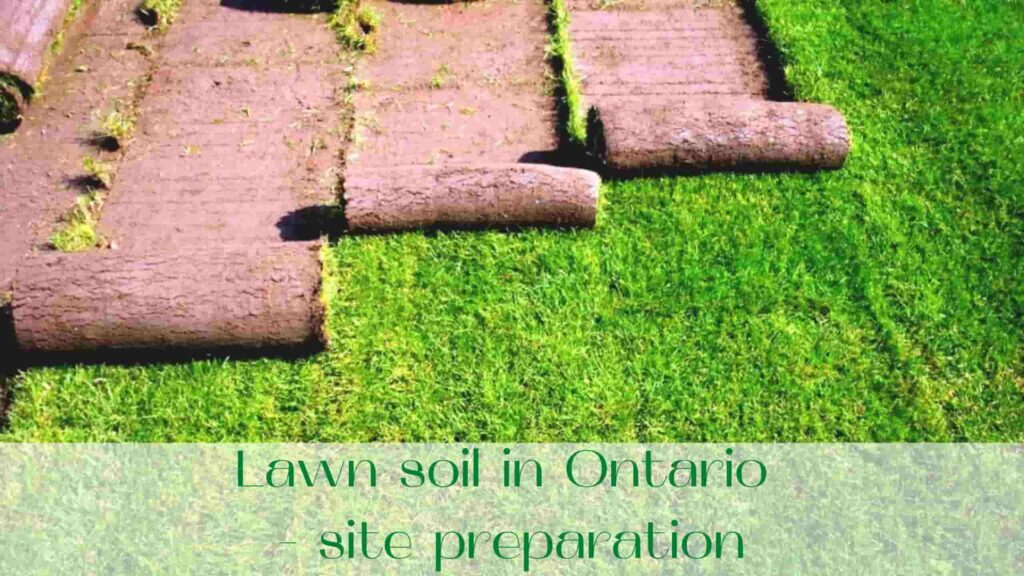
The foundation for the lawn – it’s like the foundation for a house. The most important and responsible stage. For the lawn to develop in the best way, to be lush, strong and healthy, it is necessary to create optimal conditions.
- First of all, examine the entire area under the lawn. If for some reason water stagnates somewhere after the rains or in the spring, you should make good drainage. In the future, this will save your lawn from a lot of problems. The soil must be well permeable to water and air.
- Next, we mark out the area under the lawn.
- Remove all stones, bricks, concrete bases from the plot.
- Uproot all the plants on the site: grass, flowers, shrubs and trees, if it is provided by the plan. In some cases, trees can be left behind, carrying out all the necessary work under them.
- If the site was already covered with some grass, you will have to get rid of it. There are several ways: the first is to treat it with herbicides, the second is to remove the top layer of turf. The choice of the appropriate method is up to you and depends on your personal preferences. If you are loyal to herbicides, you know that you have to treat the site at least 2 times with an interval of 3 weeks. And the seeds of lawn grass can be sown no earlier than 6 weeks after the herbicide treatment. A good compost can be made from the top layer of sod. Cut the top layer to a depth of around 5-8 cm, remove it and place it in a compost heap with the roots upwards. To speed up the rotting process, you can water the compost heap from time to time with biopreparation solutions.
- Next, the plot should be digged to the depth of the bayonet of the spade. It is not necessary to make a turnover of the layer. The main task is to fluff up the bottom layer. And for this purpose, an ordinary pitchfork will also be suitable.
Important: Do not dig over the area when it is raining or after it has rained. This will cause excessive compaction of the soil. Wait until the weather is relatively dry, when all the water has already been absorbed.
After digging, you can work on improving the soil, if necessary. Remember, if plants and grasses have been growing and thriving on the site, do not reinvent the wheel and do not bring in new soil. By the way, about the new earth is a separate conversation. It is only appropriate where it is formed naturally, i.e. in the steppe regions. If you bring the land on your dried up swamp, then your plot will again turn into a swamp, all the advantages of the land will be washed away by the first rain.
If you want to improve the properties of the soil on the site for the lawn – put compost, fertilizer, bring fertile soil, typical for your region and your climate.
- The next important step is to level the area. You will not be able to properly care for the lawn if you have hollows and humps. Therefore, the entire plot should be carefully levelled with a rake or a special technique.
- After the first stage of leveling the soil should be compacted. Otherwise, after the first watering or rain in some places in the lawn may form depressions. For compaction it is better to use a special roller. If you do not have such equipment, use some kind of plate or boardwalk. It is important that the load on the ground was even and tangible.
- Then go over the site in small steps. Those hidden cavities that were not identified using the roller and plank, you can find another way – under your weight loose soil will sag and even fall through. In such newly detected depressions you need to add soil and recompact.
After the second stage of compaction once again pass over the site with a rake and level the ground.
It is best to start laying rolled lawn in Toronto from a corner of the plot. Unroll accurately so as not to damage the sod.The very technology of laying implies that it is necessary to fill the area gradually. Neighboring rolls should be placed evenly with a minimum gap.
Lawn grass seeds in Ontario
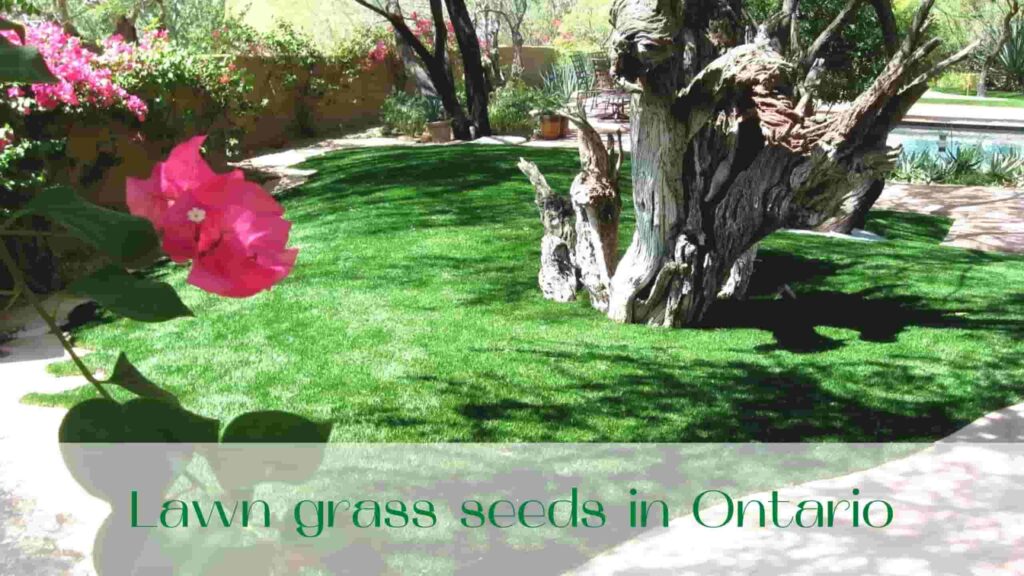
After preparing a lawn plot, seeds are the second thing you should not skimp on. First, only buy seeds from reputable companies with a high germination rate. Second, select the variety mix best suited to your climate and region.
Lawn seeds consist of several varieties of grasses that complement each other in different characteristics. Depending on the conditions: sun or shade, what type of soil on the site are selected different varietal mixtures. Exactly the purpose of the lawn: Is it merely decorative or does it have to withstand negative factors, such as trampling on the sports lawn?
If you don’t want to waste time fighting disease and mowing too often, then only buy lawn grass seed of the highest quality. This purchase will more than pay off in saved nerves.
How to sow a new lawn in Toronto
It is best to sow the lawn in autumn or spring, when the soil warms up to 12 ° C. Do not sow in the hot summer, immature lawn grass shoots will simply die, forming sparsely.
- The compacted soil on the plot should be slightly loosened with a rake to a depth of 1.5 – 2 cm.
- Next, we take the seeds at the rate of 30-50 grams per 1 m.sq.m. Divide them into two portions-halves. First, we sow, passing along the plot, and the second portion of the seeds – across. This way the seeds will be distributed more evenly.
- Now you can apply the granular multi-nutrient fertilizer and then gently tap the seeds and fertilizer in with a rake to a depth of 0,5 to 1,5 cm.
- Roll the seeds with a roller, so they are not blown away by the wind. And the contact with the soil will be better.
- The first watering is one of the most important. To ensure that the seeds are not washed out, it is better to use a fine sprinkler. About 20 liters per square meter will be enough.
The top layer of soil must be constantly moist until the first friendly shoots appear. Seeds are almost on the surface and cannot extract moisture from deeper layers of soil. So if necessary, in hot, dry weather you will have to water the lawn every day.
Rolled lawn laying in Toronto
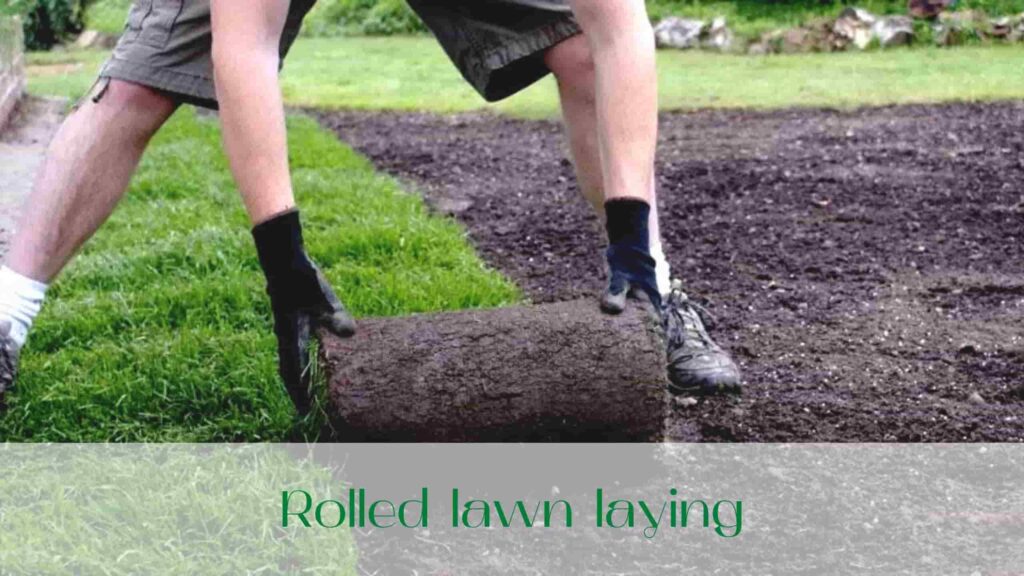
Many people have a question “what kind of lawn is better? A seeded lawn or a rolled lawn?”. The answer is always the one that is well looked after. If you don’t have time to deal with sowing lawns from seed, you can order ready-made turf in rolls.
This will reduce time and increase costs. Non-specialist will not be able to determine by eye – a quality or substandard turf roll he had brought. Therefore, you will have to trust the professionals.
The first stages of laying lawn rolls are no different from the arrangement of the seeded. It is also necessary to prepare the site, level and roll it.
It is best to start laying rolled lawn from a corner of the plot. Unroll carefully so as not to damage the turf.The very technology of laying implies that it is necessary to fill the plot gradually .
The adjacent rolls should be placed evenly with a minimum gap.
Important: Start watering the laid roll turf almost immediately after laying. Ideally, someone is still rolling out and laying the turf, and someone is already watering the lawn at the beginning of the plot. In sunny weather, start watering a maximum of one hour after laying, in cloudy weather – after 2 hours.
If you delay watering, the turf can dry out in the sunlight and wind, and the grass will turn yellow. So better 10 liters poured in time than 30 liters, but with a delay of 3 hours.
The first watering of the lawn is performed at the rate of 30 liters per square meter. Particular attention is paid to the edges of the plot, as well as heavily exposed sunny areas.
- For the first week after laying turf in Toronto, water every day in the morning and evening at a rate of 25-40 litres per metre. Towards the end of the week, fresh, thin roots should appear on the underside of the turf.
- The second week we water every 1 day. If the grass has grown to a sufficient height, carry out the first mowing.
- The third week, water 2 – 3 times a week and mow the lawn a second time if necessary. Only now cut at an angle opposite to the first cut.
After the fourth week, the rolled lawn in Toronto is completely ready for use. Remember that for the first few weeks after laying you should not walk on the lawn or do any other active activities.
Lawn care
The lawn should be cared for – this is an axiom. If you think “now I’ll throw grass seeds here and will not do anything else, they themselves will grow and will be beautiful”, then you can not even bother to think about a beautiful lawn. Leave everything as it is – couch grass will grow, it will be beautiful. Green even surface of the lawn, casting malachite – the result of painstaking and regular care.
Mowing the lawn: When to mow, how to mow and to what height
Lawns need to be cut not only for aesthetic reasons but also for practical reasons. Regular cutting regularly regularly stimulates the growth of the grass, new shoots are constantly being produced and the grass is germinating. This keeps the lawn green and yellow for a long time, even in late autumn.
Turf also grows as a result of mowing. And the stronger and thicker it is, the more successfully it can hold back weeds. Thick turf withstands more stress and is more resistant to trampling.
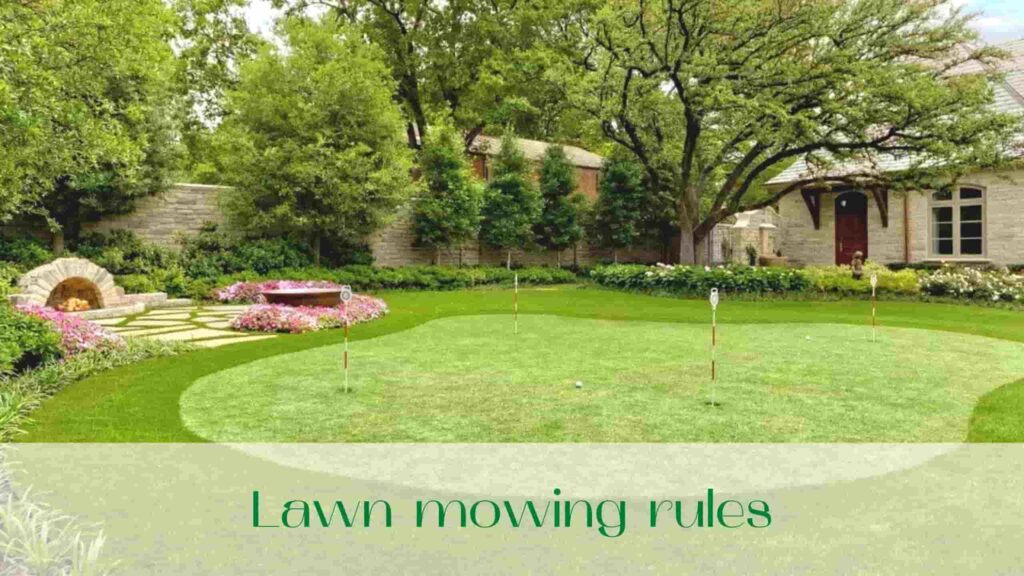
Lawn mowing rules:
- The lawn should be mowed every week. But there are times when it is necessary to mow more often, up to every day. This is the case with sports lawns, for example. The rainy season is also a reason to mow more often.
- Not less than 5 – 6 cm should be mown on a regular lawn and not less than 3 cm on a parterre lawn.
- Never cut more than 1/3 of the stem height in one cut. If you have started up your lawn and it is now 12 cm high, the first cut should be at a height of 8 cm. The second cut after 3 to 5 days should be 4 – 5 cm. This is due to the fact that mowing is a great stress to the grass. And if you immediately remove a large part of the vegetative stem, the lawn can fade and get sick.
- Each subsequent mowing of the lawn should be in the opposite direction from the previous one. It is for this purpose to make schemes of the passage of the lawnmower on the site. To do the opposite next time. Changing the direction of mowing stimulates the even development of grass, compacts the turf.
- Only mow in dry weather. Then the mower does not get clogged with wet grass, the wheels do not slip and do not leave traces.
- The blades must be sharp. Dull blades injure the stem and cause the grass to turn brown.
After mowing the main strip of lawn, the edges and any difficult areas – around trees or other obstacles – should be carefully trimmed. Garden shears or a trimmer can be used for this purpose.
The optimum time to mow your lawn depends on the region. It’s best to look at the temperature. If the average daily temperature is above +10 ° C, then you can mow. This applies to the border moments of spring and autumn.
Dry grass combing – scarifying
It is necessary to comb out the lawn in order to allow the grass to develop normally. The dense felt that forms after the winter can prevent air from getting to the grass roots. It also causes water to stagnate on the surface of the lawn, thereby increasing the risk of fungal disease.
Scarifying should be done when the topsoil is dry. You can use both an ordinary fan rake and special equipment.
At first, combing movements should be done along the plot, and then across it. The combed felt will make excellent compost.
Aeration – piercing the sod
Only dense turf should be pierced. If your Toronto lawn is only six months old, you won’t need this drastic measure. As the lawn develops, its turf gets denser and thicker.
Sooner or later there comes a point where the roots stop growing, and with them the green grass becomes less and less dense. Also, dense turf can prevent the penetration of moisture and air into the lower layers of the root layer.
An ordinary pitchfork will be good for the aeration process. It is necessary to pierce to a depth of 8 – 10 cm, with pitchfork spacing also about 10 cm. Due to the general loosening of the soil, the roots begin to grow intensively, the inflow of air and moisture to the roots increases.
Lawn watering

If you want your lawn to always be green and fresh, you can’t do without extra watering. Do not rely on natural processes. Over time, the grass will begin to wither, lose its luster, begin to dry out, and the entire lawn will turn gray or even brown.
In addition, with a lack of moisture, weeds proliferate abundantly, and lawn grasses are not able to suppress them.
- During normal times, 1 to 2 waterings per week is enough. At the rate of 20 to 40 liters per square meter. Or you can orient in another way: the soil should be well soaked to a depth of 10 cm.
- Evening is the optimal time for watering. Water is well absorbed and evaporation is less.
- In dry weather, watering should be no more than 3 – 4 times a week.
- Remember that too much moisture is scarier than too little. Water your lawn only when it has dried out.
Small sprinklers should preferably be used for watering.
Mulching
Lawn mulching in Toronto is not obligatory, but it does increase air and water permeability and encourages the growth of young grass shoots. In addition, mulch is a natural source of nutrients. A mulched lawn suffers less from the scorching sun and slows down the evaporation of moisture.
Peat and sand can be used as mulch. Mulching material should be evenly spread over the entire surface of the lawn at the rate of 1 – 2 kg per square meter.
Mulching should be done either in spring or in autumn – before the lawn goes to winter. The main thing before mulching you must mow and prick the turf.
Scarifying
Under the scary word “scarifying” there is such a thing as a vertical cut of the turf. When dense, overgrown turf stops letting water through properly, nutrients, air and water cannot reach the lower layers where the roots live. And on the surface, where water stagnates, fungal diseases can run rampant.
Cutting through the turf vertically allows water to seep into the cuts. The site as a whole is affected as a rejuvenation procedure.
Scarifying can be done only once a year – in the spring at +10 ° C, using special equipment. It is obligatory in dry weather.
During the season, the lawn can be fertilized, using complex mineral fertilizers. Remember the main rule – quick nitrogen in spring, phosphorus and potassium in autumn. Do not forget that after fertilizing the lawn must be watered.
All these recommendations are just a canvas, the basis for growing a beautiful lawn. But there are always private cases, diseases, moles and other problems. Especially from them suffer in early spring, when the snow comes off and the eye opens an unsightly picture.
A beautiful green lawn is the result of care and maintenance. Remember this. Even in winter there is work for you to keep your lawn beautiful and healthy. A lawn on a slope requires special attention.
Lawn restoration after winter – solving problems
Situation familiar to many: all last season you admired the beauty of their green lawns, and the spring, when the snow melted, your eyes appeared a dismal sight – here and there spoils, grass has faded or turned yellow, and piles left by moles. Do not be sad, the former beauty of your masterpiece can be restored.
First and foremost, you should know that many problems could have been avoided if you took care of your lawn properly during the winter:
- When the lawn is covered with snow, it should not be driven on or actively traversed. Under the footprints or wheels of a car, the grass can become crushed and dry out. When the snow level is above 30 cm, you can walk on the lawn, but very carefully. By the way, if the winter is not very snowy, it is advisable to increase the amount of snow, setting snow stops. A thick layer of snow will perfectly protect the lawn from freezing.
- With the beginning of spring an ice crust begins to form on the surface of the snow cover – you should definitely break it up. Under the ice crust the air exchange stops, this will inevitably lead to the grass drying out.
- During the period when the snow is melting massively, you can not allow water to accumulate in the hollows. If you see a puddle, use a pitchfork to cut into the ground about 10 cm down the middle.
- If snow drifts have accumulated on the lawn, they should be spread evenly over the area.
Remember that the area in the lowlands, where water always accumulates, must be equipped with good drainage.
Lawn problems in spring

So spring has sprung and you can see an unpleasant picture.
Yellow spots.
There can be several reasons for yellow spots on the lawn: Gasoline or oil were accidentally spilled when you filled up the mower, dog urine might have scorched the grass on the lawn or you yourself poured too much fertilizer containing quick nitrogen and then walked over the patch. Lack of moisture could also be the cause of the yellowing, which is unlikely after a snowy winter.
What to do? Profusely water the site with water, soaking the ground for 20 cm. When the grass has recovered, mow it. If the yellowing has not gone away, water and mow several times. If after 3-4 watering/mowing procedures the yellowing has not disappeared, then the area will have to be reseeded.
And you must teach your dog to go to the toilet on the lawn, otherwise yellow spots and even bald spots will be a permanent problem for you. Make a special place for it and be prepared for the ground to be bare.
Moss on the lawn is removed with an ordinary fan rake. Not only moss is combed out, but also old felt and fallen leaves. In places where moss has settled thoroughly and combing (scarifying) does not help, it will be necessary to remove the top layer of turf and reseed the area.
Piles of earth after earthworms can simply be swept up with a broom. Some experts recommend getting rid of earthworms on your property, but trust me, the benefits they bring to your whole property are not comparable to the effort you would put into simply sweeping the “ugly” piles off your lawn.
Make sure that compacted patches of grass on your lawn are “fluffed up”. A normal pitchfork is best for this. Use them to penetrate the ground to a depth of 8 – 10 cm and do not trample over the matted areas.
If you do not solve the problem of compacted areas, over time, the grass will simply grow out and disappear there. The fact is that dense felt and turf do not let water and air to the grass roots. It is advisable to aerate with a rake several times a season.
Lawn Spots
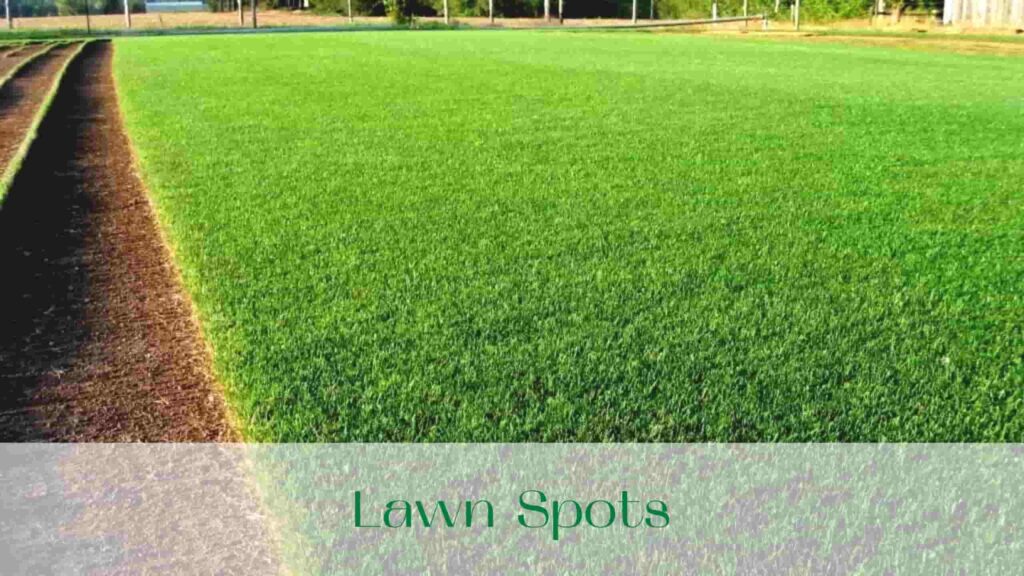
There are several reasons for lawn spits:
- Places where ice or snow drifts have accumulated – become extinct first.
- Places where water accumulated during mass snowmelt – get soaked.
- Unsuitable varieties of grasses were sown. For example, bluegrasses do not take root in the shade.
How to deal with thawing is described above. It can be simply avoided by carrying out certain procedures in winter. For shady areas, choose special grass mixes called “park grasses.”
If there is already a gaps, it is necessary to perform a “patching” repair.
- Cut out the spoiled section of sod.
- Pour fresh fertile soil.
- Sow seeds in a layer of 1 – 1.5 cm evenly.
- Deepen into the ground with a rake.
- Water.
Be sure to use seeds of the same variety mix as the whole lawn, otherwise the newly sown area will be different in color.
Moles in the lawn
Piles of soil after moles, like hills in the steppe, do not add beauty to the green lawn. To discourage moles from the site can be different ways: sound deterrents, mothballs, it helps if you sow along the perimeter of the site leguminous grass.
Earth hills can simply be carefully collected with a shovel and taken out of the plot, the rest of the soil should be pushed into the burrow. Then the site should be observed. After the first rain, the soil may settle. Then simply top up the soil and sow new grass.
A beautiful green lawn in Ontario is the result of care and attention. Remember this. Even in winter, there’s work for you to do to keep your lawn beautiful and healthy.
A beautiful green lawn is the result of care and attention. Remember this. Even in winter, there’s work for you to do to keep your lawn beautiful and healthy.
And “Captain Handy” company will help you with any difficulties connected with your lawn and will do the lawn laying quickly and qualitatively.
